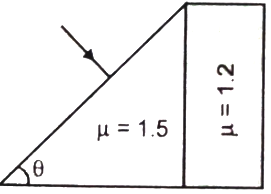The average value of the focal length of a normal eye-lens is
(1) 2 cm
(2) 25 cm
(3) 100 cm
(4) infinity
एक सामान्य नेत्र-लेंस की फोकस दूरी का औसत मान है
(1) 2 cm
(2) 25 cm
(3) 100 cm
(4) अनंत
A glass slab is placed with the right angle prism as shown in the figure. The possible value of such that light incident normally on the prism does not pass through the glass slab is:

1.
2.
3.
4. Both 1 & 2
जैसा कि चित्र में दर्शाया गया है एक काँच स्लैब को समकोण प्रिज़्म के साथ रखा गया है। का वह संभावित मान ज्ञात कीजिए जिसके लिए प्रिज़्म पर आपतित अभिलंबवत् प्रकाश काँच के टुकड़े से होकर नहीं गुजरता है:

1.
2.
3.
4. 1 और 2 दोनों
A plano-convex lens of focal length 20 cm is silver painted on its plane, as shown. The distance of the image of object O from the lens-mirror system is:

(1) 5 cm
(2) 10 cm
(3) 15 cm
(4) Infinity
जैसा कि दिखाया गया है, 20 cm फोकस दूरी के एक समतल-उत्तल लेंस के समतल पर चांदी का रंग चढ़ा हुआ है। लेंस-दर्पण प्रणाली से वस्तु O के प्रतिबिंब की दूरी है:

(1) 5 cm
(2) 10 cm
(3) 15 cm
(4) अनंत
A convex lens A of focal length 20 cm and a concave lens B of focal length 5 cm are kept along the same axis with the distance d between them. If a parallel beam of light falling on A leaves B as a parallel beam, then distance d in cm will be
| 1. | 25 | 2. | 15 |
| 3. | 30 | 4. | 50 |
20 cm फोकस दूरी के उत्तल लेंस A और 5 m फोकस दूरी के अवतल लेंस B को समान अक्ष के अनुदिश एक-दूसरे से d दूरी पर रखा गया है। यदि A पर गिरने वाली प्रकाश की समांतर किरण, B से समांतर किरण के रूप में निकलती है, तब दूरी d का मान cm में कितना होगा?
| 1. | 25 | 2. | 15 |
| 3. | 30 | 4. | 50 |
A boy with defective eye-sight cannot see things beyond 50cm. The corrective lens required has the power
1. +1D
2. +2D
3. -1D
4. -2D
दोषपूर्ण दृष्टि वाले एक लड़के को 50 cm के आगे की वस्तुएँ नहीं दिखाई देती हैं। निवारण लेंस के लिए आवश्यक क्षमता है
1. +1D
2. +2D
3. -1D
4. -2D
One face of a rectangular glass plate 6 cm thick is silvered. An object held 8 cm in front of the first face, forms an image 10 cm behind the silvered face. The refractive index of the glass is [Consider that light ray returns back in the first medium]
| 1. | 0.4 | 2. | 0.8 |
| 3. | 1.5 | 4. | 1.6 |
6 cm चौड़ी कांच की आयताकार प्लेट का एक फलक रजतित है। एक वस्तु जिसे पहले फलक के सामने 8 cm पर रखा गया है, रजतित फलक से 10 cm पीछे प्रतिबिंब का निर्माण करती है। कांच के अपवर्तनांक की गणना कीजिए [विचार कीजिए कि प्रकाश किरण पहले माध्यम में वापस लौट गई है]
| 1. | 0.4 | 2. | 0.8 |
| 3. | 1.5 | 4. | 1.6 |
Two identical equiconvex thin lenses each of focal lengths 20 cm, made of material of refractive index 1.5 are placed coaxially in contact as shown. Now, the space between them is filled with a liquid of refractive index 1.5. The equivalent power of this arrangement will be:

1. + 5D
2. Zero
3. + 2.5D
4. + 0.5D
20 cm फोकस दूरी, 1.5 अपवर्तनांक के पदार्थ से निर्मित दो आदर्श समोत्तल पतले लेसों को दर्शाए गए अनुसार समाक्षीय रूप में संपर्क में रखा गया है। अब इनके मध्य के स्थान को 1.5 अपवर्तनांक के तरल से भरा गया है। इस समायोजन की समतुल्य क्षमता कितनी होगी?

1. + 5 D
2. शून्य
3. + 2.5 D
4. + 0.5 D
A ray of light falls on the surface of a spherical glass paperweight making an angle with the normal and is refracted in the medium at an angle . The angle of deviation of the emergent ray from the direction of the incident ray
1.
2.
3.
4.
एक प्रकाश-किरण हल्के गोलीय कांच पर अभिलंब के साथ कोण बनाती हुई गिरती है और माध्यम में कोण पर अपवर्तित होती है। आपतित किरण की दिशा से निर्गत किरण के विचलन कोण की गणना कीजिए।
1.
2.
3.
4.
A ray of light is incident at an angle of incidence, i, on one face of a prism of angle A (assumed to be small) and emerges normally from the opposite face.If the refractive index of the prism is the angle of incidence i, is nearly equal to
(a) (b)
(c) (d)
प्रकाश की किरण i आपतन कोण से, A प्रिज्म कोण (न्यून माना जाता है) के फलक पर आपतित होती है और विपरीत पृष्ठ से अभिलंबवत निर्गत होती है। यदि प्रिज्म का अपवर्तनांक है, आपतन कोण, लगभग बराबर है -
(a) (b)
(c) (d)
The magnification of a compound microscope for the final image at least distance of distinct vision is 90. The magnification of the objective lens is 15. The value of the focal length of the eyepiece will be
1. 5 cm
2. 6 cm
3. cm
4. 12 cm
स्पष्ट दृष्टि की न्यूनतम दूरी पर अंतिम प्रतिबिंब के लिए संयुक्त सूक्ष्मदर्शी का आवर्धन 90 है। अभिदृश्यक लेंस का आवर्धन 15 है। नेत्रिका की फोकस दूरी का मान होगा
1. 5 cm
2. 6 cm
3. cm
4. 12 cm






